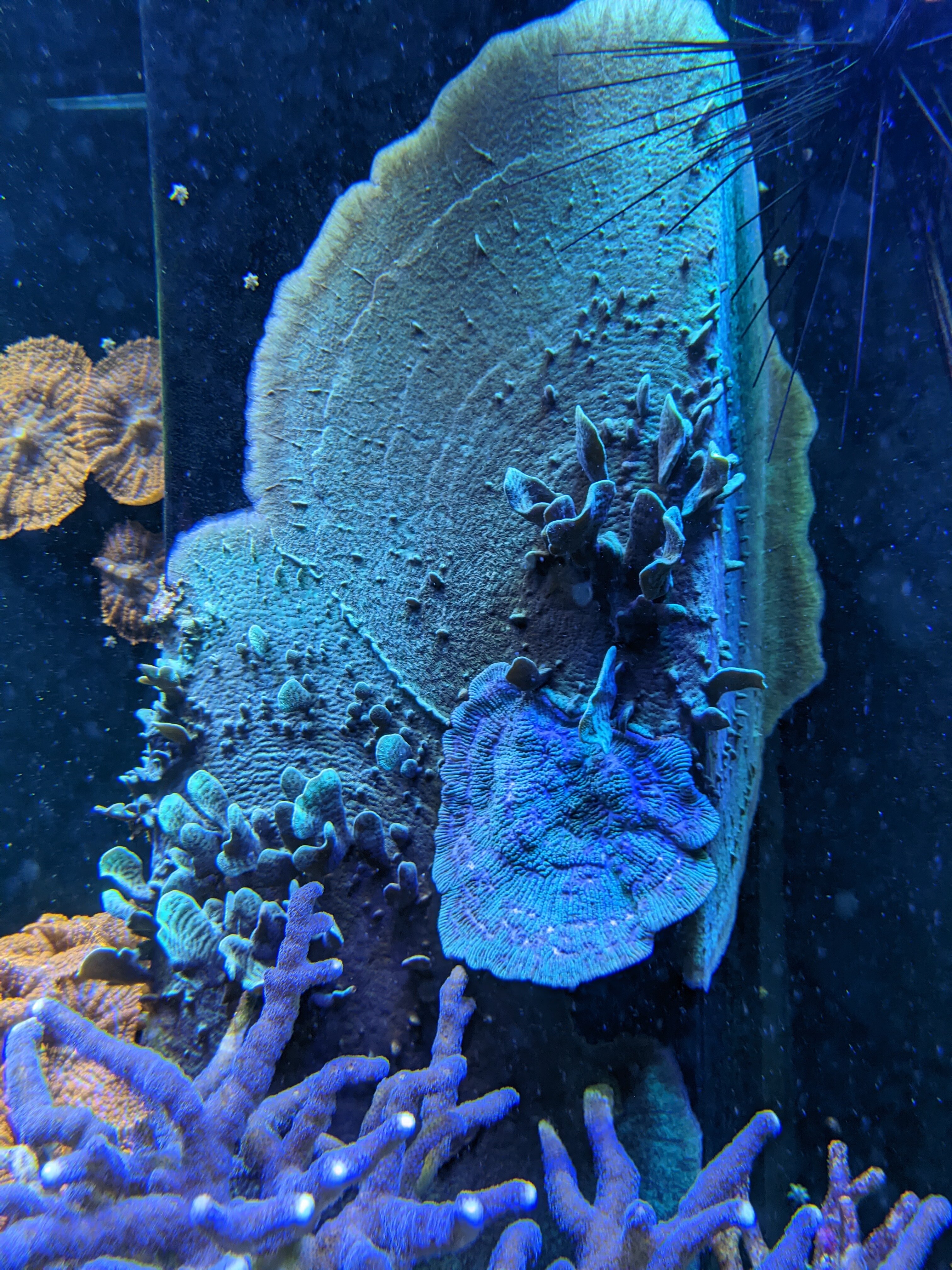I've got cyano. How should I deal?
Background: 3 month old 40 breeder with 20L sump (55g total volume), ATO with RO/DI (0 TDS)
Filtration: 24/7 skimmer (w/ scrubber), large marinepure block, AF Life Bio Fil, 40 lbs (give or take) live rock, GAC reactor (6 TBSP rox), GFO reactor (as needed, currently offline), 1"-1.5" sand bed
Lighting: Neptune Sky ramping up to 70%, 12 hour photoperiod on continuous ramp to max at midday. Starting off blue, transitioning to AB+, then 3 hours of about 12k, back to blue.
Flow: 2x Tunze 6040, 1x Vortech MP10, 200 gph return pump
Supplements: AF Probiotic method (2 drops -NP Pro, Pro Bio S, ABEV), Neophos (1 mL/day), AF Life Source (20 mL/week), AF Component 1+, 2+, 3+
Control/Integration: Apex, Trident, 2x DOS, VDM (for Tunze 6040 control)
Food:
Daily: 1 mL AF liquid vege, AF liquid mysis, AF liquid artemia, AF plankton elixer, 0.3 mL AF tiny fish food pellets, AF fish-v
3x/week: 1 mL Oyster Feast, 1 mL AF Phytoplankton, 8 drops Brightwell Garlic Power
Weekly: 0.3 mL benepets, 0.3 mL AF pure food, 0.3 mL AF growth boost, 0.3 mL AF LPS food, 0.3 mL AF zoa food, 0.3 mL AF power food, 1 cube marine fusion
Maintenance schedule:
1. Weekly: 10% water change, clean skimmer cup, vacuum sump detritus, stir sand, replace GAC, blow detritus off rocks
2. Monthly: Replace 20% Life Bio Fil
Parameters:
Temp: 79.5
pH: 7.9-8.1
Salinity: 35 ppt
Nh3: 0
No2: 0
No3: 10.8
Po4: 0.028
Alk: 7.6-7.8
Ca: 520 (lowering to 420, dosing accident)
Mg: 1400
Livestock: 2x Ocellaris Clowns, 1x Cherub Pygmy Angel, 1x Scooter Blenny, 1x Yellow Watchman Goby, 1x Tiger pistol shrimp, 1x BTA, 1x cleaner shrimp, 10x blue leg hermits, 5x nassarius snails, 5x trochus snails, 1x emerald crab, various SPS (mostly monti, 2x acro - all growing), zoanthis (some of these waste away), LPS (growing)




Background: 3 month old 40 breeder with 20L sump (55g total volume), ATO with RO/DI (0 TDS)
Filtration: 24/7 skimmer (w/ scrubber), large marinepure block, AF Life Bio Fil, 40 lbs (give or take) live rock, GAC reactor (6 TBSP rox), GFO reactor (as needed, currently offline), 1"-1.5" sand bed
Lighting: Neptune Sky ramping up to 70%, 12 hour photoperiod on continuous ramp to max at midday. Starting off blue, transitioning to AB+, then 3 hours of about 12k, back to blue.
Flow: 2x Tunze 6040, 1x Vortech MP10, 200 gph return pump
Supplements: AF Probiotic method (2 drops -NP Pro, Pro Bio S, ABEV), Neophos (1 mL/day), AF Life Source (20 mL/week), AF Component 1+, 2+, 3+
Control/Integration: Apex, Trident, 2x DOS, VDM (for Tunze 6040 control)
Food:
Daily: 1 mL AF liquid vege, AF liquid mysis, AF liquid artemia, AF plankton elixer, 0.3 mL AF tiny fish food pellets, AF fish-v
3x/week: 1 mL Oyster Feast, 1 mL AF Phytoplankton, 8 drops Brightwell Garlic Power
Weekly: 0.3 mL benepets, 0.3 mL AF pure food, 0.3 mL AF growth boost, 0.3 mL AF LPS food, 0.3 mL AF zoa food, 0.3 mL AF power food, 1 cube marine fusion
Maintenance schedule:
1. Weekly: 10% water change, clean skimmer cup, vacuum sump detritus, stir sand, replace GAC, blow detritus off rocks
2. Monthly: Replace 20% Life Bio Fil
Parameters:
Temp: 79.5
pH: 7.9-8.1
Salinity: 35 ppt
Nh3: 0
No2: 0
No3: 10.8
Po4: 0.028
Alk: 7.6-7.8
Ca: 520 (lowering to 420, dosing accident)
Mg: 1400
Livestock: 2x Ocellaris Clowns, 1x Cherub Pygmy Angel, 1x Scooter Blenny, 1x Yellow Watchman Goby, 1x Tiger pistol shrimp, 1x BTA, 1x cleaner shrimp, 10x blue leg hermits, 5x nassarius snails, 5x trochus snails, 1x emerald crab, various SPS (mostly monti, 2x acro - all growing), zoanthis (some of these waste away), LPS (growing)




















